3 Ways to Classify Magnetic Circuits in Permanent Magnet Motors
Classification of Magnetic Circuit
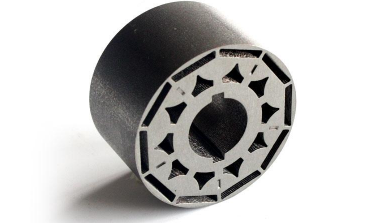
Permanent magnet magnetic circuit can be divided into static permanent magnet magnetic circuit and dynamic permanent magnet magnetic circuit according to the different working state of permanent magnet. Static permanent magnet magnetic circuit has a fixed air gap, the working state to maintain a certain, mainly in the instrumentation, speakers, etc., the figure is a static permanent magnet magnetic circuit. Dynamic permanent magnet magnetic circuit of the magnetic resistance or external magnetic field is in the change, the working point of the permanent magnet also changes, the magnetic circuit of the permanent magnet motor is a typical dynamic permanent magnet magnetic circuit.
The magnetic circuit of a permanent magnet motor is a typical dynamic permanent magnet circuit. The armature structure of a permanent magnet motor is the same as that of an electrically excited motor, with the main difference being that the magnetic poles of the former are permanent magnets. Permanent magnet motor magnetic circuit of various forms, there are many different classification methods.
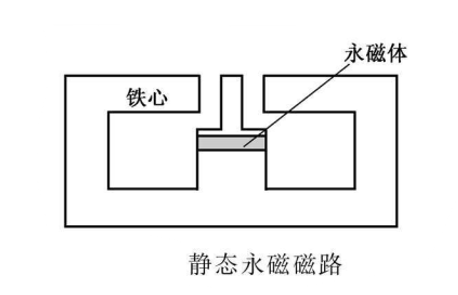
1, according to the location of the permanent magnet classification
According to the position of the permanent magnet, it can be divided into rotating pole type and rotating armature type. Figure (a) for the rotating pole type magnetic circuit structure, the permanent magnet in the rotor, the armature is stationary, permanent magnet synchronous motor, brushless DC motor are used in this structure; Figure (b) for the rotating motor area type magnetic circuit structure, its permanent magnet in the stator, the armature rotates, the permanent magnet DC motor uses this structure.
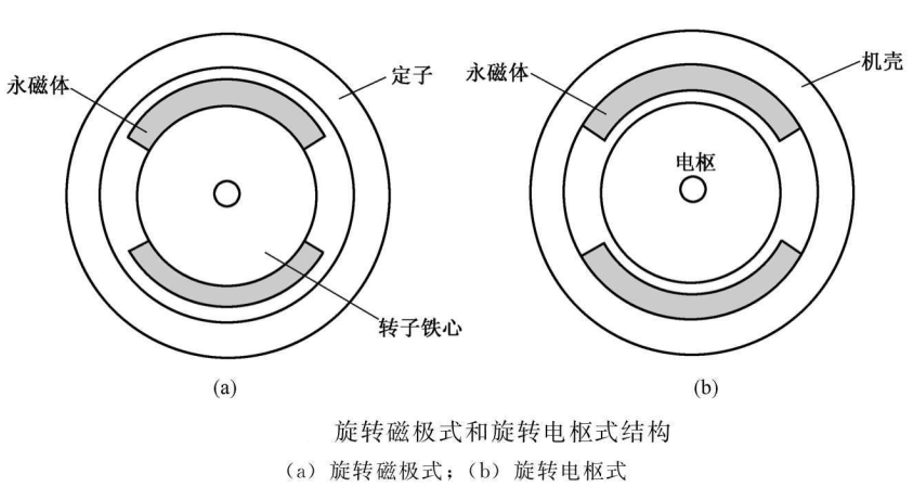
2, according to how many types of permanent magnet material used classification
According to the number of types of permanent magnet materials in the motor, can be divided into a single structure and mixed structure. In a motor, only one kind of permanent magnet material is used, which is called single structure, and the majority of motors adopt this kind of structure. If two or more permanent magnet materials are used in the same motor, it is called hybrid structure. Hybrid structure usually uses two different performance characteristics of the permanent magnet, to avoid the shortcomings, give full play to the advantages of permanent magnet materials, improve the performance of the motor and reduce manufacturing costs. The figure below shows the hybrid pole structure of permanent magnet DC motor, the low coercivity permanent magnet 1 (such as ferrite) is placed in the front of the pole, and the high coercivity permanent magnet 2 (such as neodymium-iron-boron) is placed in the back of the pole.
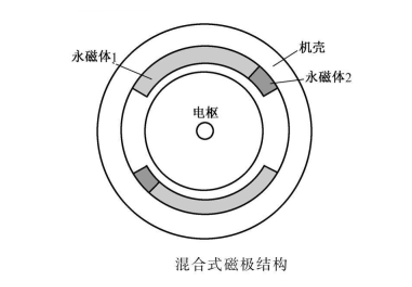
3、Classified according to the placement of permanent magnets
According to the different ways of permanent magnet placement, it can be categorized into surface type (surface paste type) and built-in type (embedded type), as shown in the figure below. Surface-type pole of the permanent magnet directly facing the air gap, with the advantages of easy processing and installation, but the permanent magnet directly withstand the armature reaction of the demagnetization effect; built-in pole of the water magnets placed inside the core, processing and installation process is complex, leakage of magnetism is large, but can be placed in a larger number of permanent magnets in order to improve the air gap magnetism, reduce the weight and volume of the motor.
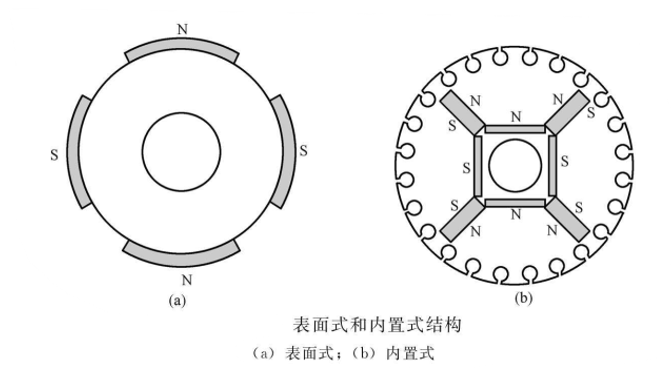
4、Categorized by the shape of the permanent magnet
When designing permanent magnets, it is necessary to ensure that the permanent magnets produce sufficient magnetic flux and magnetic potential in the magnetic circuit, if the permanent magnet material used is different, the shape of the permanent magnet is also different. Alnico remanent magnetic density is high, coercivity is small, usually made of elongated shape; ferrite and rare earth permanent magnet material coercivity is large, due to its relative remanence permeability close to 1, magnetoresistance is large, when the magnetization direction length increases to a certain extent, continue to increase the magnetization direction length, the magnetic flux provided by the permanent magnet to the external increase is very small, so usually use flat structure. According to the different shapes of permanent magnets, they can be divided into tile-shaped, arc-shaped, ring-shaped, claw-pole type, star-shaped and rectangular magnetic poles.
(1) Tile Shape
In permanent magnet motors, tile-shaped poles are widely used. There are two types of tile-shaped poles, concentric tile-shaped poles and equal radius tile-shaped poles, as shown in the figure below. Since the blank of sintered NdFeB material is rectangular, it is generally processed by wire cutting method, and the material utilization rate of concentric tile-shaped pole is low, generally 40%~50%. The use of equal radius tile-shaped pole structure, both to improve material utilization, but also to reduce the cost of wire cutting processing, permanent magnet material utilization can be increased to 80%.
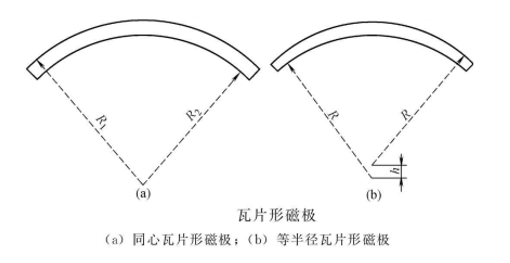
(2) Arc-shaped
Arc-shaped magnetic poles constitute the magnetic circuit system shown in the figure below. This type of pole is arc-shaped and magnetized along the arc direction, characterized by the magnetic flux of each pole provided by two permanent magnets in parallel, and the magnetization direction has a large length, which is suitable for Alnico permanent magnets.
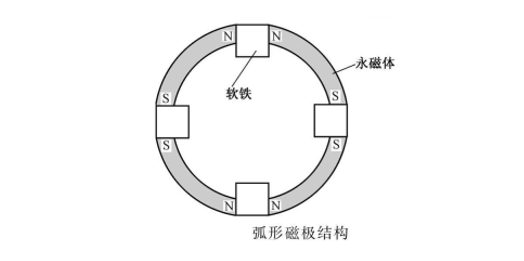
(3) Ring
The toroidal magnetic pole, shown in the figure below, is an integral ring, which has the advantages of simple structure, easy processing and assembly, and is widely used in permanent magnet DC motors. Its main disadvantages are low material utilization and the existence of magnetic field in the geometric neutral line, which is not conducive to the commutation of permanent magnet DC motor.
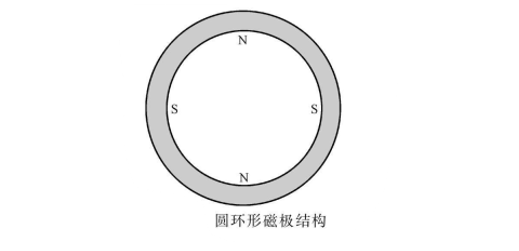
(4) Claw pole type
Permanent magnet claw pole type pole is composed of a permanent magnet ring and two flanges with claws, permanent magnet ring axial magnetization, flanges are usually made of mild steel or made of steel plate punching, there is a uniform distribution of claws on the claw, claw number is equal to the number of poles, as shown in the figure below. Permanent magnets and two flanges set on the rotor shaft, the two flanges of the claw alternately staggered half a claw distance, two flanges on the claw were N, S pole. In order to avoid the magnetic flux through the rotor shaft closure, generally use a non-magnetic shaft or magnetic shaft with a magnetic copper sleeve. When the axial length of the magnetic pole is large, in order to ensure the mechanical strength of the claw pole, often made into a double claw pole or multi-claw pole type.
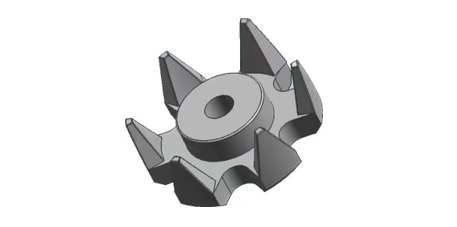
(5) Star
Star-shaped magnetic pole structure is shown in the figure below, the structure is more complex, the use of direct casting method, between the pole part of the non-magnetic materials (such as aluminum alloy) casting, can improve its strength and has a damping effect. The advantage is that the manufacturing and assembly process is simple, but magnetization is difficult and the magnetization is not uniform.
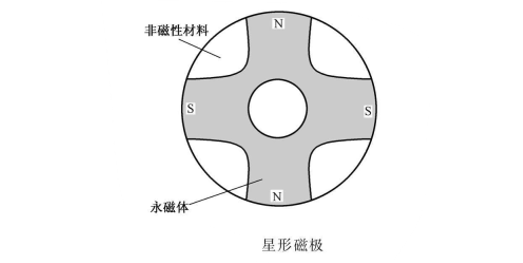
(6) Rectangular
Rectangular pole consists of one or several rectangular permanent magnets. Rectangular permanent magnets are simple in structure, convenient in processing and high in material utilization, such as built-in permanent magnet synchronous motors usually use rectangular permanent magnets. When designing the shape of the permanent magnet, the ratio of the length to the thickness of the rectangular permanent magnet should be avoided to be more than 20, and the thickness of the ferrite must be more than 2mm.
















